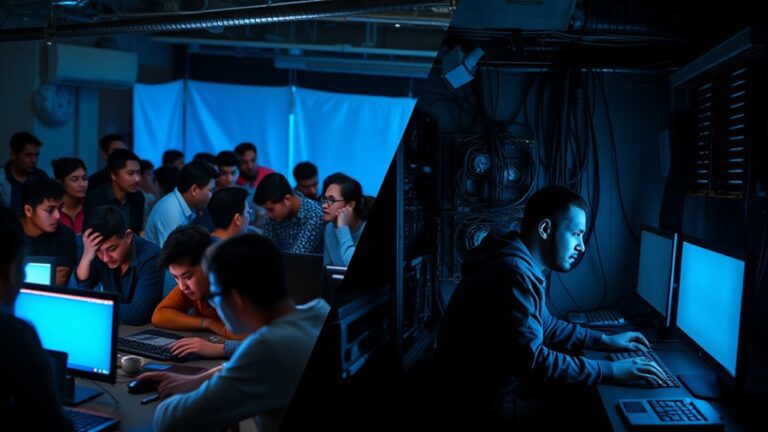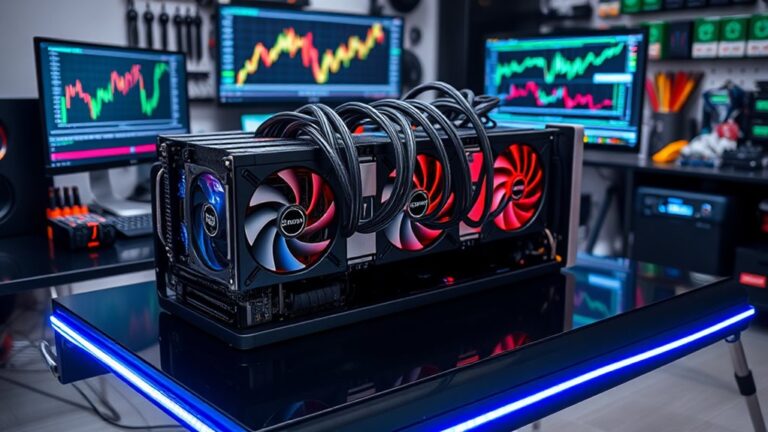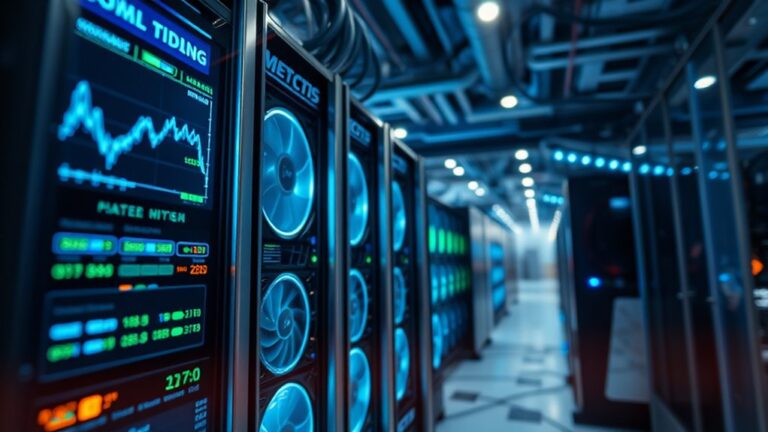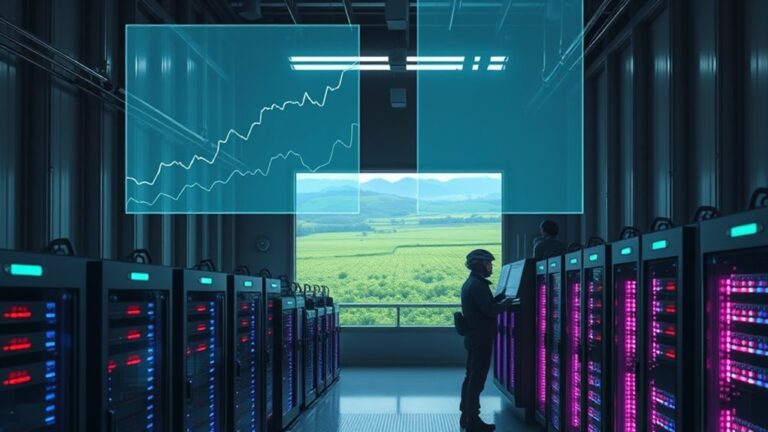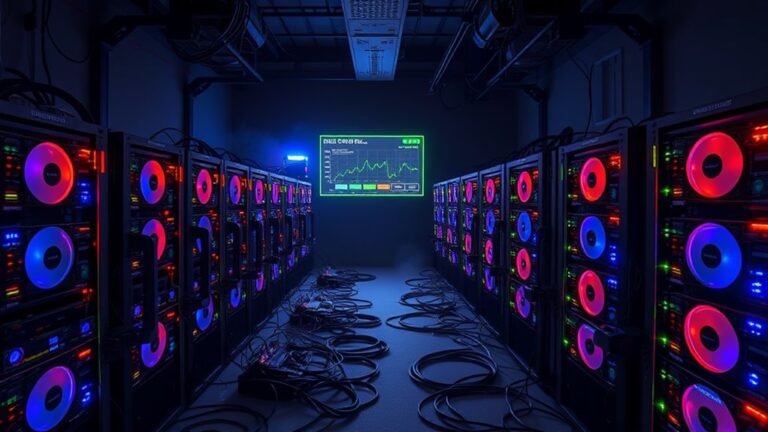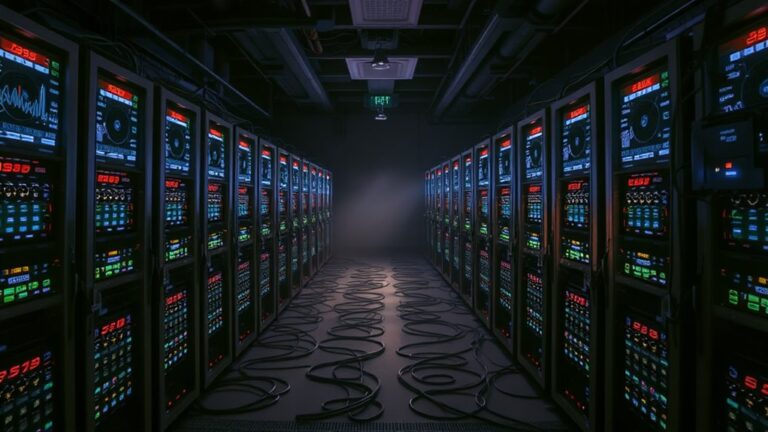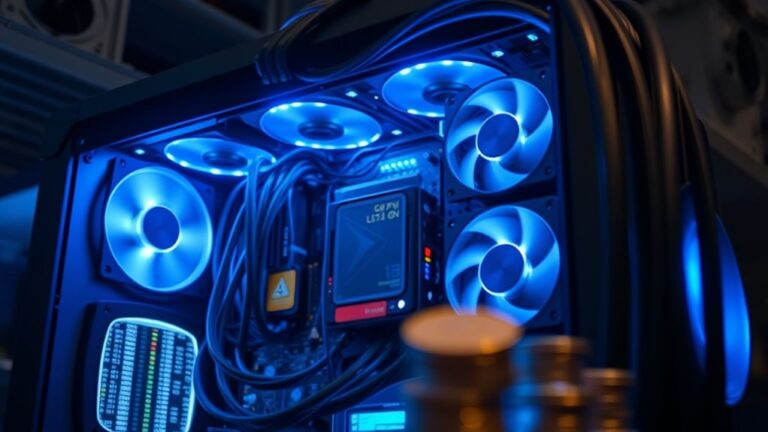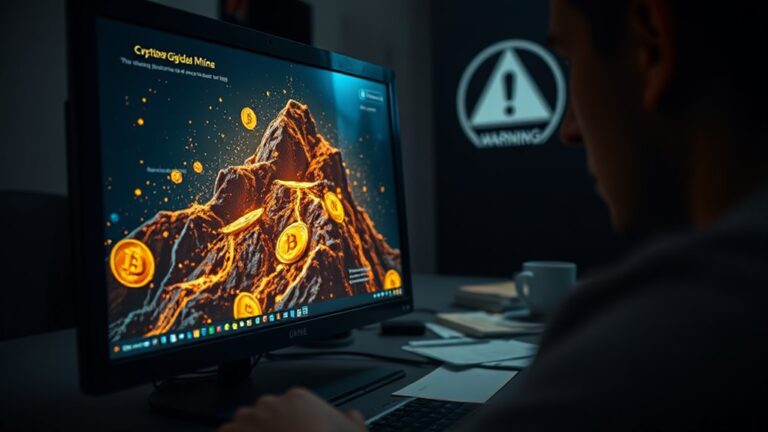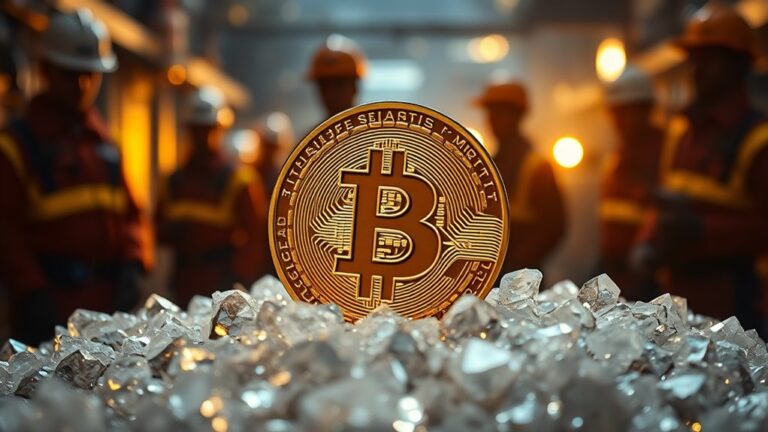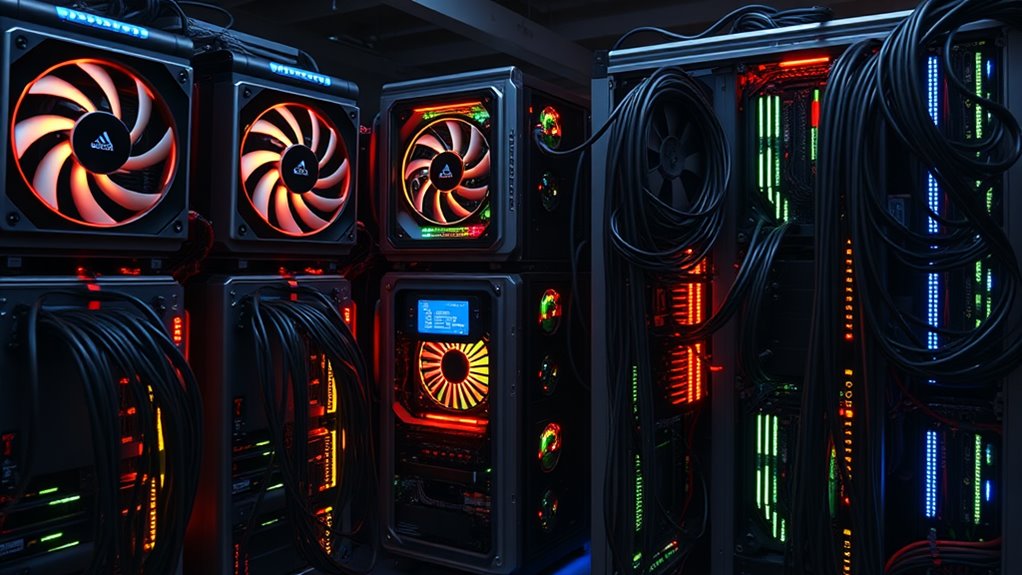
Mining Hardware: Essential Components for Successful Crypto Mining
Mining hardware consists of several vital components for effective cryptocurrency mining. These include a motherboard, graphics card (GPU), power supply, cooling system, and a CPU. The GPU plays a key role in solving complex equations, while the power supply guarantees all parts function properly. Factors like hash rate, power consumption, and hardware compatibility are essential for selecting the right components. Understanding these elements can enhance mining efficiency and profitability. Further details on hardware types and costs can provide deeper insights.
Key Takeaways
- The motherboard connects all components, enabling effective communication between hardware parts for successful mining operations.
- A powerful graphics card (GPU) is essential for solving cryptographic equations and maximizing mining efficiency.
- A reliable power supply is crucial to provide consistent energy to all components and maintain operational stability.
- An effective cooling system is necessary to prevent overheating, ensuring the longevity and performance of the mining hardware.
- Considering hash rate, power consumption, and initial cost helps in selecting the most profitable mining hardware setup.
Key Components of Mining Hardware
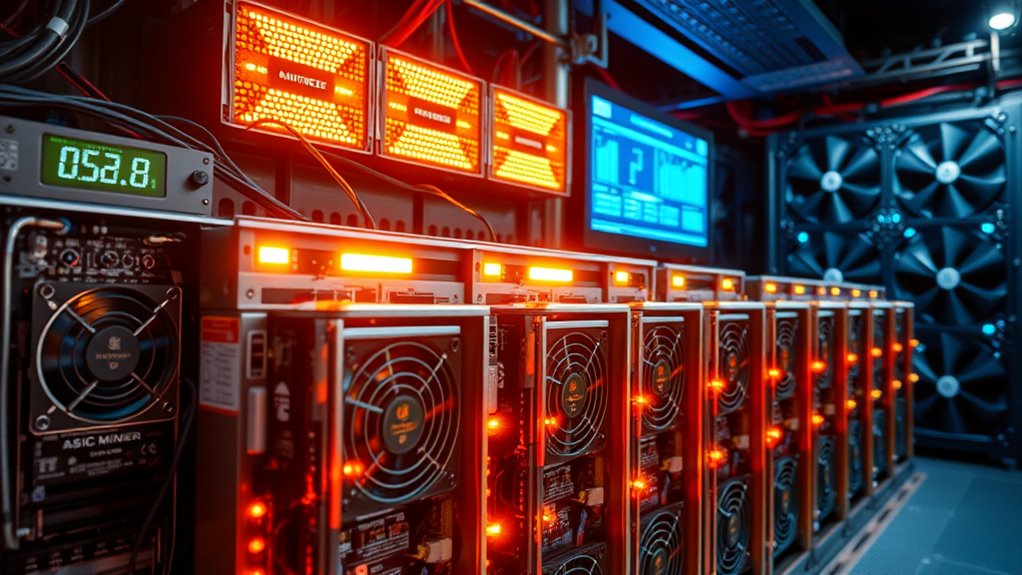
The key components of mining hardware form the foundation of a successful cryptocurrency mining operation. Central to this setup is the motherboard, which connects all individual parts.
The graphics card, or GPU, is crucial for solving cryptographic equations, greatly impacting mining efficiency. A reliable power supply is essential, as it provides energy to all components.
To prevent overheating, an effective cooling system is necessary. The CPU manages various operational tasks that do not require intense calculations.
Additionally, an appropriate operating system, mining software, and storage devices are required for proper functioning. Other supportive elements, such as risers for improved airflow and a stable internet connection, complete the mining setup, ensuring peak performance in cryptocurrency mining endeavors. Understanding energy efficiency is vital for maximizing profitability in your mining operation.
Factors Influencing Hardware Selection
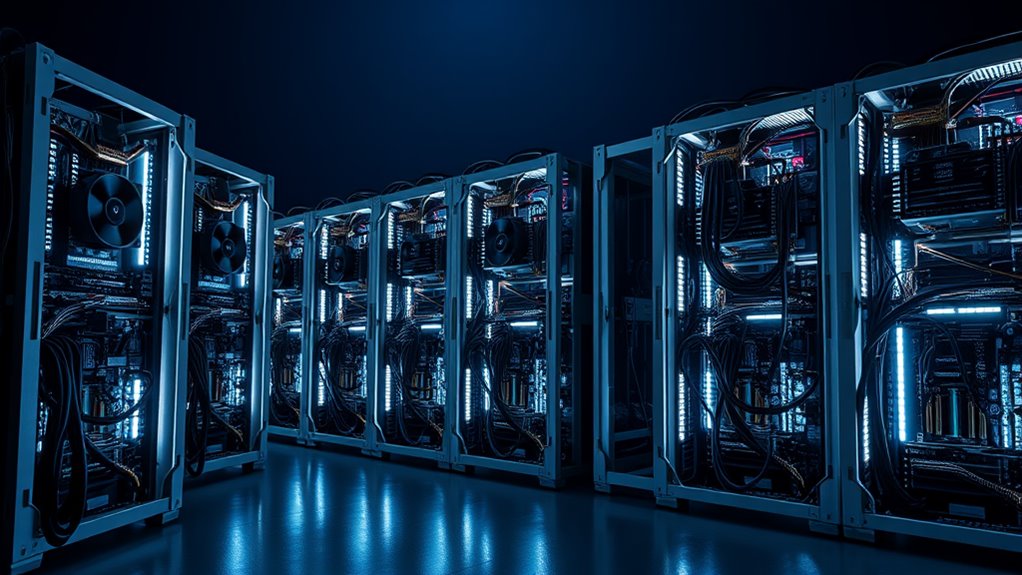
Selecting the appropriate mining hardware involves considering various factors that can considerably impact performance and profitability. These factors include hash rate, power consumption, initial cost, operational requirements, and compatibility. Each aspect plays a critical role in ensuring effective mining operations.
| Factor | Description |
|---|---|
| Hash Rate | Determines chances of solving puzzles and rewards. |
| Power Consumption | Influences electricity costs and overall efficiency. |
| Initial Cost and ROI | Affects upfront investment and long-term profitability. |
Evaluating these factors helps miners choose hardware that meets their needs while maximizing returns. Understanding hardware compatibility and futureproofing also assists in making informed decisions that cater to evolving market conditions and operational demands. Additionally, considering energy-efficient hardware can lead to significant long-term savings on electricity costs.
Types of Mining Hardware Available
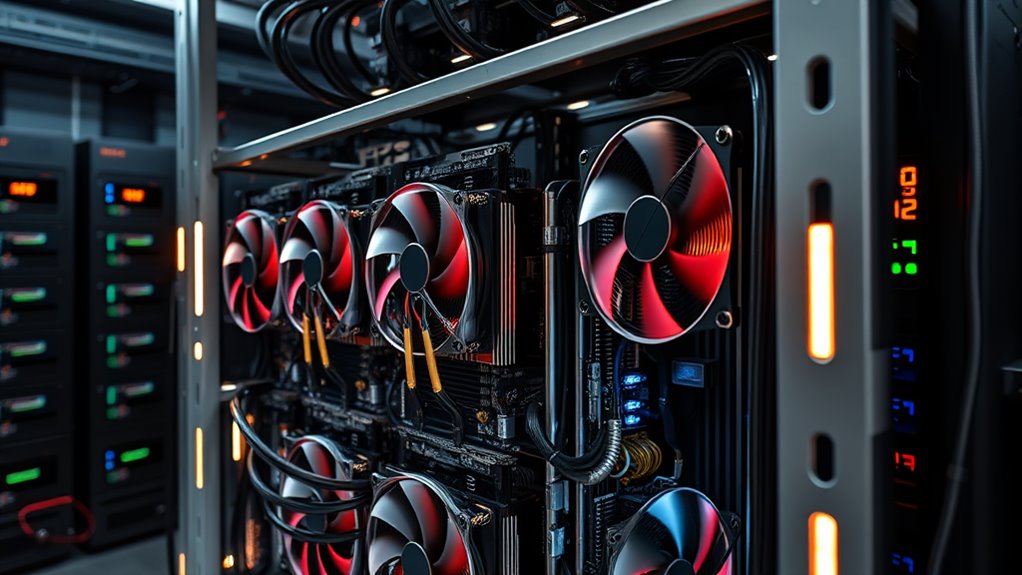
Mining hardware comes in various forms, each suited to different types of cryptocurrencies and mining strategies.
CPU miners utilize central processing units, ideal for low-demand cryptocurrencies, but they exhibit low hash rates and high energy consumption.
GPU miners leverage graphics processing units, providing flexibility and efficient parallel processing for various coins, especially before Ethereum’s shift to proof of stake.
ASIC miners, or application-specific integrated circuits, offer high hash rates and energy efficiency, dominating Bitcoin mining due to their specialization.
FPGA miners, using field-programmable gate arrays, provide adaptability for specific applications.
Finally, cloud mining enables users to rent computing power online, allowing access to mining without purchasing hardware, making it a less capital-intensive option for newcomers. This method is particularly appealing for those who prefer a hands-off approach to mining without the need for substantial upfront investment in hardware.
Understanding Costs and Profitability
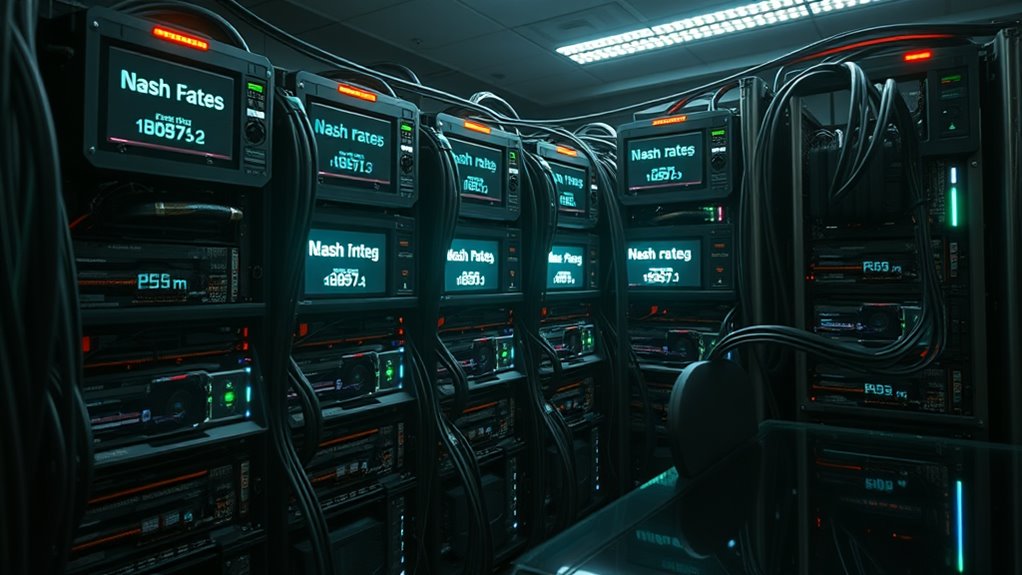
Understanding the financial aspects of cryptocurrency mining is essential for anyone considering entering this competitive field. The costs involved can greatly impact profitability, and potential miners should be aware of the following factors:
- Hardware Cost: Investing in efficient mining hardware can range from $1,320 to $14,521.
- Electricity Costs: Energy expenses vary by location and can greatly influence overall profits.
- Maintenance Fees: Regular upkeep is necessary to extend the lifespan of mining equipment.
- Market Volatility: Fluctuations in cryptocurrency prices can lead to unpredictable earnings.
A thorough understanding of these components allows miners to calculate potential returns accurately, ensuring informed decisions in a rapidly changing environment. Additionally, the shift towards renewable energy sources is helping reduce costs and increase profitability for miners.
Addressing Environmental and Regulatory Challenges
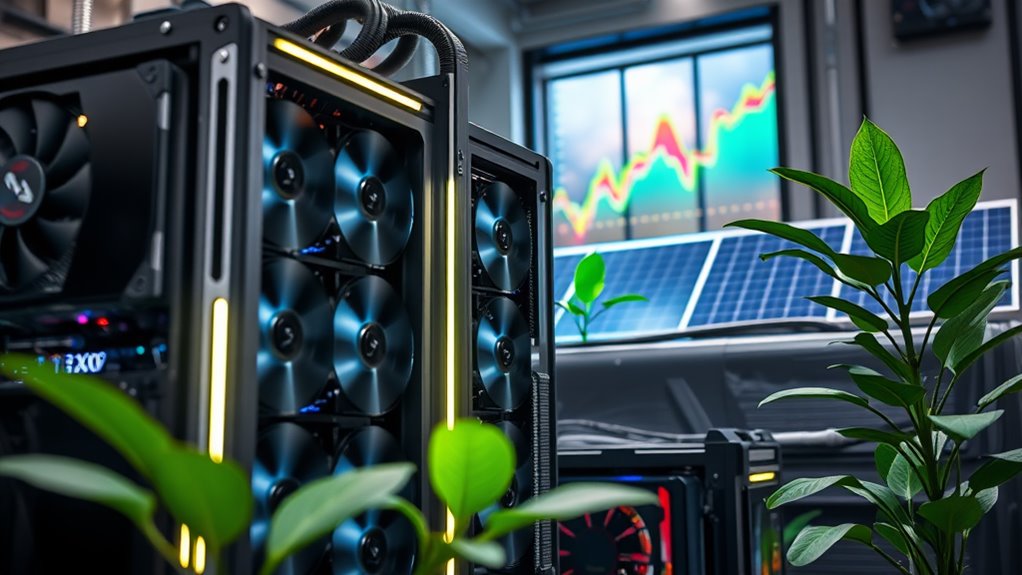
How can the cryptocurrency mining industry address its growing environmental and regulatory challenges? The industry faces significant scrutiny over its energy consumption, carbon emissions, and e-waste generation. To respond, mining operations can adopt sustainable practices and innovative technologies. Below is a summary of potential strategies:
| Challenge | Sustainable Solution |
|---|---|
| High energy consumption | Shift to renewable energy sources |
| Significant carbon emissions | Implement carbon offset programs |
| E-waste generation | Develop efficient mining hardware |
| Regulatory pressure | Engage with policymakers for incentives |
| Public perception | Increase transparency in operations |
Moreover, mining companies can learn from strategies used in sustainable mining techniques to further reduce their environmental impact.
Frequently Asked Questions
How Do I Choose the Right Mining Software for My Hardware?
Choosing the right mining software involves evaluating compatibility with hardware, ensuring user-friendly interfaces, optimizing performance, and prioritizing security features. Assessing community support and updates can further enhance mining efficiency and overall experience.
What Are the Best Practices for Maintaining Mining Hardware?
Best practices for maintaining mining hardware include regular cleaning, ensuring proper ventilation, monitoring temperatures, updating software, and managing power supply. These steps help optimize performance, enhance efficiency, and prolong the lifespan of the equipment.
How Does Overclocking Impact Mining Performance and Hardware Lifespan?
Overclocking substantially boosts mining performance by increasing hash rates, but it also raises power consumption and risks overheating, which can shorten hardware lifespan. Effective cooling and monitoring are essential to balance performance and hardware longevity.
Can I Use My Gaming PC for Mining?
Using a gaming PC for mining is feasible, as it typically contains powerful GPUs. However, factors like heat generation, power consumption, and hardware wear should be carefully considered to guarantee efficiency and longevity during mining operations.
What Are the Security Risks Associated With Mining Hardware?
The security risks associated with mining hardware encompass malware threats, unauthorized access, physical theft, and operational disruptions. These vulnerabilities can greatly impact efficiency, asset safety, and overall profitability in cryptocurrency mining operations.
Conclusion
In conclusion, successful crypto mining relies on understanding the essential components of mining hardware, including processing power and efficiency. Factors such as energy consumption, costs, and profitability also play critical roles in hardware selection. As miners traverse the landscape, they must consider environmental impacts and regulatory issues, akin to steering a ship through rocky waters. By staying informed and making strategic choices, individuals can enhance their mining operations while adapting to a rapidly evolving industry.

